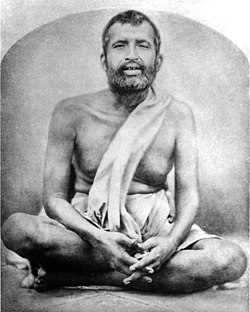Ramakrishna Quote
Related Quotes
About Ramakrishna
Ramakrishna (18 February 1836 – 16 August 1886), also called Ramakrishna Paramahansa (Bengali: রামকৃষ্ণ পরমহংস, romanized: Ramôkṛṣṇo Pôromohôṅso; pronounced [ramɔkriʂno pɔromoɦɔŋʃo] ; IAST: Rāmakṛṣṇa Paramahaṃsa), born Ramakrishna Chattopadhay, was an Indian Hindu mystic. He was a devotee of the goddess Kali, but adhered to various religious practices from the Hindu traditions of Vaishnavism, Tantric Shaktism, and Advaita Vedanta, as well as Christianity and Islam. His parable-based teachings advocated the essential unity of religions and proclaimed that world religions are "so many paths to reach one and the same goal". He is regarded by his followers as an avatar (divine incarnation).
Ramakrishna was born in Kamarpukur, Bengal Presidency, India. He described going through religious experiences in childhood. At age twenty, he became a temple priest at the Dakshineshwar Kali Temple in Calcutta. While at the temple, his devotional temperament and intense religious practices led him to experience various spiritual visions. He was assured of the authenticity and sanctity of his visions by several religious teachers.
In 1859, in accordance with then prevailing customs, Ramakrishna was married to Sarada Devi, a marriage that was never consummated. He was initiated into sannyasa in 1865 by Tota Puri, a vedanta monk. Ramakrishna gained widespread acclaim amongst the temple visiting public as a guru, attracting social leaders, elites, and common people alike. Although initially reluctant to consider himself a guru, he eventually taught disciples and founded the monastic Ramakrishna Order. His emphasis on direct spiritual experience instead of adhering to scriptural injunctions has been influential. Ramakrishna died due to throat cancer on the night of 15 August 1886. After his death, his chief disciple Swami Vivekananda continued and expanded his spiritual mission, both in India and the West.
Ramakrishna was born in Kamarpukur, Bengal Presidency, India. He described going through religious experiences in childhood. At age twenty, he became a temple priest at the Dakshineshwar Kali Temple in Calcutta. While at the temple, his devotional temperament and intense religious practices led him to experience various spiritual visions. He was assured of the authenticity and sanctity of his visions by several religious teachers.
In 1859, in accordance with then prevailing customs, Ramakrishna was married to Sarada Devi, a marriage that was never consummated. He was initiated into sannyasa in 1865 by Tota Puri, a vedanta monk. Ramakrishna gained widespread acclaim amongst the temple visiting public as a guru, attracting social leaders, elites, and common people alike. Although initially reluctant to consider himself a guru, he eventually taught disciples and founded the monastic Ramakrishna Order. His emphasis on direct spiritual experience instead of adhering to scriptural injunctions has been influential. Ramakrishna died due to throat cancer on the night of 15 August 1886. After his death, his chief disciple Swami Vivekananda continued and expanded his spiritual mission, both in India and the West.
